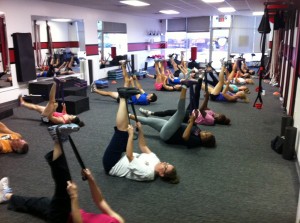When and How to Implement Youth Stretching with Bands

By Dave “The Band Man” Schmitz
When should a young athlete begin stretching? That is a very debatable question that I feel would have several strong arguments for and against. Personally, I have never felt doing band stretching with athletes younger than 14 was a good thing because of how hypersensitive their nervous systems are to passive overpressure stretching. Passive overstretching of young athletes for years seem to be very noxious to the neuromuscular system and resulted in kids just putting their body through unnecessary stress that the body was not mature enough to handle. Plus, emotionally, young teenage athletes were not ready to handle the focus needed to avoid compensation.
I still find many of these circumstances still exist, but with the help of my son Carter, I am starting to look at this aspect of youth training as something that could be successful if implemented correctly.
When Carter was 13 years old and going into 8th grade, he and I started working on flexibility with bands more frequently. Carter always moved very well for his age, but before 8th grade, he went through a 2-inch grow spurt that dramatically increased hamstring and hip rotation tightness. Carter played soccer and football, and he became very interested in being a kicker for football, which is why we decided to pursue implementing a more rigorous stretching program. Interestingly, after 6 weeks of consistent band stretching, we have seen his accuracy and consistency in distance go from 20 to 30 yards. Now, I am not discrediting the importance of practice, but based on his improved movement quality, I believe his increased hamstring and hip rotation mobility has definitely assisted in his improvement.

Recommendations for Youth Stretching with Bands
If you are going to start a youth (age 12-14 years old) stretching program, here are a few recommendations.
- Begin by using a micro orange band before progressing to a red band. It’s very important to not over tension young athletes but instead allow them to easily perform the movements without the band dominating them.
- As their trainer or parent, you need to help them learn the movements and positions. They will need manual guidance for at least 2-3 sessions before they can do by themselves.
- Start with 1 or 2 stretches and gradually implement the others as they master the initial stretches. Again, keep in mind that this is not fun stuff and the motivation to perform will probably not be there early on. Until they see improved results, getting them to do this will take some one-on-one support
- Stretch slowly but actively with 2-3 second holds maximum and very rhythmical movement. Let them know that this takes patience and cannot be rushed through. Carter very often stretches out while watching a show on television. All I ask is that he make sure he pushes into those restricted regions.
- Stretching the hip flexor-quad mechanism is not one of the stretches because to effectively do that stretch, the athlete must have optimal stabilization awareness. I find young athletes struggle with this and do much better stretching out those muscles doing a more active lunge-reach approach.
The video below will take you through what stretches I feel you should start with.
Good luck and feel free to shoot me your comments below.
Getting BETTER with BANDS
Dave Schmitz
PS If you are interested in purchasing bands for following this stretching routine, I recommend the Small Single Band Package. The Black and Purple bands that come with this will be effective for lower body strength training and speed training if not for the stretching program.


This is a great article that I will forward to my parents. Lots of times in baseball, I find that it’s the simplest things that prevent kids from executing a baseball movement…no flexibility, tight hips and hamstrings.
Follow MD&I Baseball Academy on Facebook.